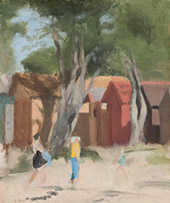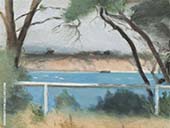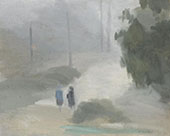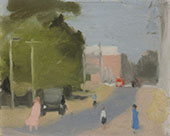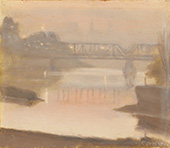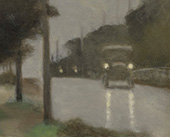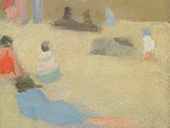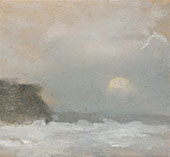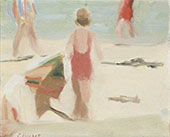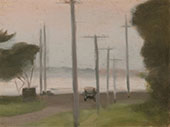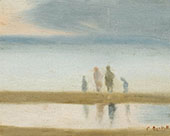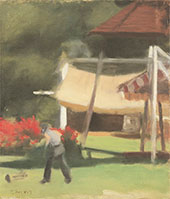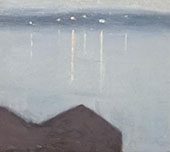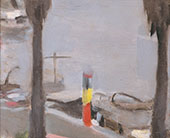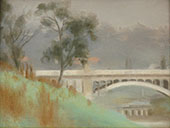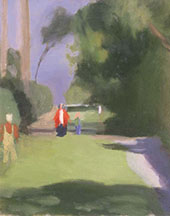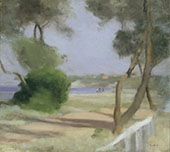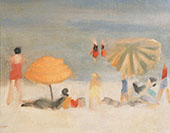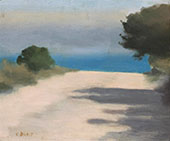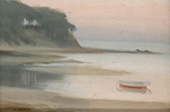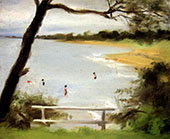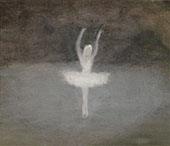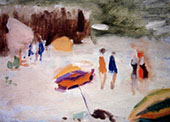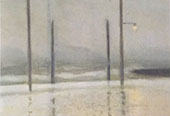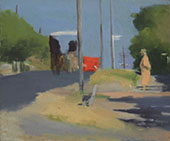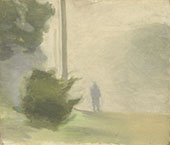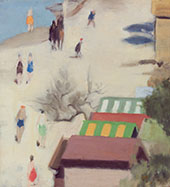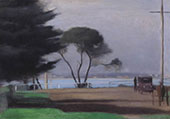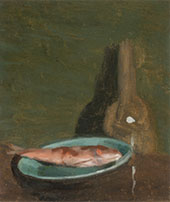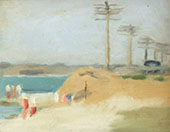Clarice Beckett Oil Painting Reproductions
Clarice Beckett replica paintings on Canvas for sale
Who is Clarice Beckett?
Clarice Beckett was the daughter of a bank manager, born in the small town of Casterton, Victoria. She stayed in Casterton for the earlier part of her studies but later boarded at Queen’s College Ballarat for secondary school. Here, the young Clarice revealed her artistic talents, developing a life-long passion for drawing. Consequently, Clarice enrolled in private drawing lessons while at Ballarat. She left these lessons when the family moved to South Yarra but finished her secondary education at a nearby grammar school.
In 1914, Clarice Beckett enrolled at Melbourne’s National Gallery School. Associated with the National Gallery of Victoria, it was a prestigious private fine art college. Under the tutelage of Frederick McCubbin and Max Meldrum, her work blossomed. Around 1919, Beckett’s parents moved again. This time they moved to Beaumaris, a Melbourne bayside suburb. Unfortunately, her parents’ health soon failed, necessitating that she undertake nearly all the household duties and caring responsibilities. Consequently, Clarice Beckett solely painted at dawn and dusk. Caring for her parents dominated the majority of her days. Despite seeming adversity, the unique dawn and dusk light characterized Clarice Beckett’s Tonalism art. Her ability to reflect the shifting patterns of light, wind, and nature made her one of the leading tonalist Australian painters. Indeed, some have referred to Beckett as the “daughter of Monet” and a famous female artist who revolutionized Modern Art in Australia.
Clarice Beckett - Famous Oil Paintings
Clarice Beckett famous paintings of Beaumaris produced some of her best-loved works. These include the vivid sunshine of Summer Day Beaumaris, the melancholic Beaumaris Seascape, and the stunning beauty of Moonrise, Beaumaris. Beckett faced strong critical opposition as a female artist and a tonalist Australian painter. Even her early teacher Max Meldrum argued that female artists expect to do things equally well as men were “sheer lunacy. He described the artists’ life as unnatural and impossible for women. During the 1920s, critics criticized the “dreariness” of her perpetual fogs, while others commented on the fuzziness and weakness of her drawing. Despite this, Beckett’s critical reception improved in the 1930s, with one reviewer comparing her to James McNeil Whistler, Rembrandt, and Jean-Baptiste Corot.
Only after she died in the mid-1930s did critics begin to appreciate Clarice Beckett paintings and use of Tonalism. One reviewer described her ability to create fascinating glowing, opalescent landscapes. Another review published in The Bulletin particularly admired her tonalism painting of 'motor headlights gleaming through evening mist.' Indeed, Beckett loved painting cars and man-made lights. They feature in paintings such as Motor Lights 1929, St Kilda Road 1930, and Taxi Rank 1931.
What are Clarice Beckett Famous Paintings Worth?
While no major gallery purchased Clarice Beckett’s paintings during her lifetime – almost every Australian public institution now proudly displays her art. Today, her work sells for six-figure sums. For example, winter Sunset was sold in October 2021 for AU$125,000. Beckett is celebrated today as a great modernist painter. Famed for transforming modern canvas art in Australia, she left a powerful legacy. Although she was highly talented at producing still-life and portraiture oil paintings, Clarice Beckett loved painting landscapes and seascapes. Her paintings reflect rural scenes, beaches, and rolling landscapes. These beautiful views are all enveloped in the atmospheric mists of early mornings and evenings. There’s an undoubtedly distinct mixture of vulnerability and calm in Clarice Beckett Tonalism paintings, reflecting the quiet stoicism of her life.
Clarice Beckett Tonalism Paintings
As a leading proponent of Australian Tonalism, Clarice Beckett utilized the methods her early teacher Max Meldrum outlined. He prized scientific theories of light and form as a strong proponent of layering paintings with a 'tone on tone' approach. Beckett consequently layered paints in the strict order she perceived these tonal impressions. However, she departed from other strict “meldrumites” with a greater focus on color. Max Meldrum believed tone, i.e., relative lightness and darkness of one color palette, should always take precedence over color.
Despite this, many Clarice Beckett paintings, such as Summer Morning, Beaumaris, and Hawthorn Tea Gardens 1933, demonstrate her deep appreciation of the full spectrum of light, color, and form. One of her latest dated paintings, Bathing Boxes 1934, demonstrates Beckett’s distinctive ability to merge the tonalist movement’s focus on light and dark with her uniquely soft color palette and unique forms.
When did Clarice Beckett Die?
Clarice Beckett stayed true to her love of seascapes art and landscape paintings, ultimately killing her. In 1935, Beckett set out to paint the coast outside Beaumaris during a terrible storm. Four days later, she died of pneumonia on 7 July 1935. She was just 48 years old.
In 1936, Beckett’s sister and father organized a major exhibition of Clarice Beckett paintings at the Melbourne Athenaeum. They celebrated her life and worked as part of the show. Despite critical acclaim during her lifetime, many Clarice Beckett paintings were subsequently abandoned. Finally, in 1971, 2,000 of her works were discovered, left to the elements, in a rural hayshed. Unfortunately, most of her paintings were beyond rescue. Happily, though, around thirty paintings were later salvaged from the Montsalvat Artists’ Colony in Melbourne. Numerous exhibitions have since celebrated Clarice Beckett as a famous Australian artist, including a 1995 joint show with the photographer Olive Cotton at the University of New South Wales, Ivan Dougherty Gallery. Subsequent retrospectives have toured galleries around the country. Beckett’s most recent exhibition, as part of the 2021 Adelaide Festival, drew massive crowds.
Celebrating the artist’s legacy, her previous school, Ballarat Grammar, holds the annual Clarice Beckett Prize for art students.
Discover famous paintings by Australian artist Clarice Beckett. Oil painting reproductions are for sale by other famous artists, Frederick McCubbin, Stella Bowen, Penleigh Boyd, Arthur Streeton, and Agnes Goodsir.
Testimonial from Hugh Jones, Wellington, New Zealand
Cannot Find What You Are Looking For?
Reproduction Gallery Information
Customer Service
(Send Us A Message)
Tel: (503) 937 2010
Fax: (503) 937 2011


